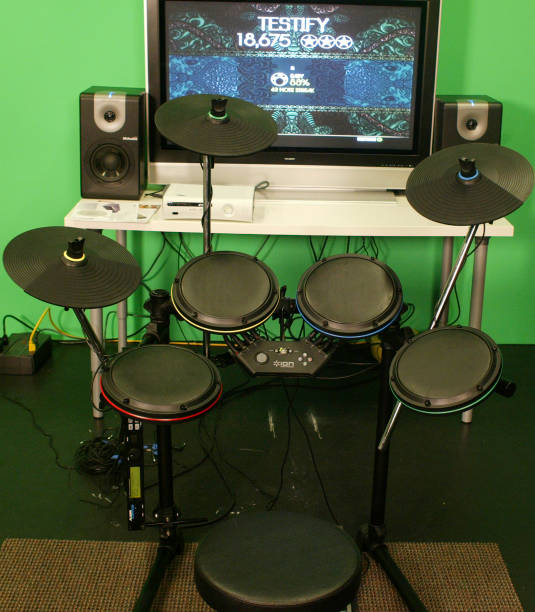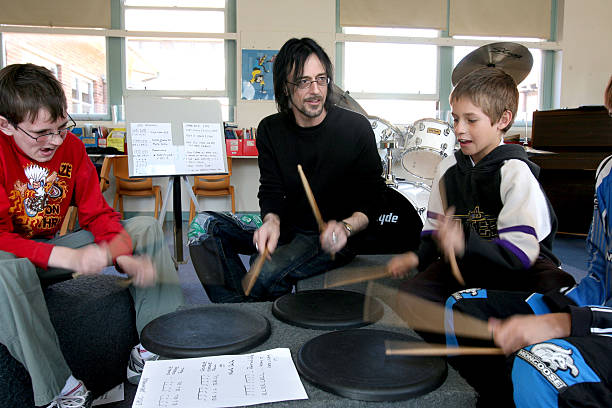Are you looking to master the drums but find yourself without a drum set? Are you trying to find the pressing answer to, How to Learn Drums Without a Drum Set. Are space constraints, budget limitations, or the need for quiet holding you back from practicing? You’re not alone, and there’s a solution that doesn’t involve a traditional drum set.
Learning to play the drums can be a fun and rewarding experience, but buying a drum set isn’t always in the cards. Luckily there are multiple ways to learn and practice drumming without literally sitting down on a kit.
Practice on a pillow
This is one of the best Beginner Drum Exercises at Home. The answer to the question, How to Learn Drums Without a Drum Set starts here. Any surface can be used a drum! When it comes to ways to learn drums Without a drum set, you can grab a pair of drumsticks (or some long cooking utensils) and practice on a pillow.
It’s softer than a drum head, so it’ll tire you out more quickly because you’ll be using mostly wrists. Think of it like a workout but if and when you do sit down on a drum kit, the rebound will make playing it much easier!
If you want to experiment with different sounds, you try other household items – like a ‘snare drum’ made of a plastic container filled with rice or beans.
What should you practice? Start with a few drum rudiments – the building blocks of all drumming – and you’ll develop major skill with your hands.
Practice Pads

Another way of drumming practice without equipment is Practice Pads. Practice pads are the easiest way to practice your drumming without a drum set, and probably the closest replication of a drum set out of all of the methods. Practice pads are ingeniously designed to replicate the response and feel of actual drum heads, providing a silent yet effective means for mastering sticking exercises and rudiments. Here’s a closer look at how to leverage these tools:
- Selecting the Right Practice Pad: Consider factors such as pad size, playing surface, and additional features like cymbal stand threads for a more customized practice setup. For instance, smaller pads offer portability, while larger ones deliver a more realistic feel, essential for transitioning to an actual drum set.
Diverse Options for Varied Needs:
- Aquarian Super-Pad: Offers a realistic feel and is portable, ideal for drummers seeking a medium-tuned experience.
- Evans RealFeel: Known for its durable, natural gum rubber surface providing excellent rebound.
- Drumeo P4: Features four different playing surfaces, catering to drummers looking for diversity in practice textures.
- Innovative Practice Techniques: Beyond traditional stick practice, consider using brushes or household items on a couch to diversify your skillset. For foot technique, a kick pad like the Drumeo QuietKick can simulate the bass drum experience. Additionally, sound-off pads significantly reduce volume for those with an actual drum set, so you can practice at any hour.
Air Drumming
This is touted as one of the best alternative ways to practice drums. So if you want to learn or practice songs without gear, pretend you have an invisible drum set and go to town. But make sure you practice deliberately; try to tap your legs and move your arms in time along to music.
You can even pick up a fun piece of tech like DrumPants — a wearable drum machine that lets you get real drum sounds by tapping your legs — or Aerodrums (shop in Europe) — a special set of drumsticks and camera so you can drum in VR).
Pots, pans and cardboard boxes
Get creative with your kitchen utensils and make yourself a drum kit! However, if you hit a pot or pan with a drum stick it will be very loud, so either tape the ends of some old drum sticks or tape a towel onto the pot. Cardboard boxes and other ‘junk’ can make great sounds too.
Body percussion
Experiment with drumming out rhythms on your own body. Not only does it help you practice, but you also (literally) feel the rhythm. Try some loose coins or a set of keys in one of your pockets for a more snare-like sound.
Beatboxing

Beatboxing is the act of making percussive sounds with your mouth. You don’t need to be a vocal gymnast to try beatboxing, just remember one of our favourite sayings: “If You Can Say It, You Can Play It“. Verbalising rhythm is a very important part of internalising rhythm.
Technology to practice without drums
Today, there are various products available to help you practice when you’re away from the drum set.
Immersive Air Drumming:
DrumPants and Aerodrums: These innovative products replicate drum sounds as you ‘air drum’, providing a more immersive practice experience.
Virtual Reality (VR) Drumming: Engage in a virtual drumming environment, perfecting your skills with a realistic drum set simulation.
Pad Controllers:
Immersive Practice experience: Unlike air drumming, finger drumming provides the physical feedback you’re used to from the drum set. This helps enormously with developing muscle memory and the dynamics of your playing.
Development of Rhythm & Timing: Using Pad Controllers for finger drumming is an excellent way to practise & develop timing and rhythm. Check out our finger drumming lessons to find out more.
Recording and Playback: Many pad controllers feature loop recording functions, allowing drummers to record their rhythms and play them back. This is invaluable for self-assessment, as it provides immediate feedback on timing accuracy and rhythmic tightness.
Rhythm and Timing:
Metronomes and Drum Machines: Utilize apps like Tempo Lite and Pro Metronome to maintain consistent timing, whilst you hit practice pads or other household items.
Virtual Drum Set: Websites like virtualdrumming.com offer free access to virtual drum sets, allowing you to practice rhythms and learn about setups used by famous drummers.
Learning and Development:
Online Drum Lessons: Platforms like Melodics provide professional lessons and resources.
Digital Audio Workstations (DAWs): Free software like Audacity and Pro Tools Intro can be used to record your sessions, helping to identify areas for improvement. You can program drum patterns which makes them great for ideation that you can take to the drum set next time you’re on the drum stool.
Drumless Tracks: Practice along with songs by using drumless tracks to develop your musicality and timing.
Incorporating these technological tools into your practice routine not only broadens your learning resources but also keeps you engaged and motivated, making the journey of learning to play drums without a drum set both effective and enjoyable.
Developing Coordination and Rhythm
Developing coordination and rhythm is a cornerstone of drumming that requires a multifaceted approach. Here’s how to enhance these skills:
Metronome Practice:
Start with a slow tempo to get comfortable.
Gradually increase speed to challenge your timing.
Use different metronome beats to practice various rhythms
Rudiment Exercises:
Single and double strokes, paradiddles, and flams are essential. Practice these on different surfaces to build versatility.
For limb independence, start with simple beats and progressively add complexity by integrating different limbs one at a time.
Coordination Drills:
Three-Way Coordination: Focus on mastering control over the snare drum, bass drum, and hi-hat individually, then in combination.
Limb Isolation: Practice each limb individually to improve muscle memory, then combine them for complex rhythms.
Innovative Techniques: Incorporate body percussion, beatboxing, and even tap dancing to internalize rhythm and improve timing.
Finger Drumming with Pad Controllers:
Simulate the drum set experience: Finger drumming helps in developing ambidexterity and coordination, while simulating real drum sounds.
Building Coordination: Finger drumming requires the use of both hands to create rhythms, much like playing a traditional drum set.
Rhythm and Timing Practice: With a variety of built-in metronomes and rhythm patterns, pad controllers offer an excellent platform to practice timing.
Remember, mastering coordination and rhythm takes time and patience. Consistent practice, along with these targeted exercises, will significantly enhance your drumming skills without needing a drum set.
FAQs
- What are some methods to practice drumming when I don’t have access to a drum set?
You can explore several creative ways to practice drumming without a drum set:
- Use a practice pad, which is a portable surface designed to emulate the feel of a drum head.
- Finger drumming on pad controllers
- Drum on a pillow to simulate the drumming surface.
- Engage in air drumming to practice your movements and timing.
- Mentally work through beats and rhythms.
- Experiment with a virtual drum set online or via apps.
- Take up tap dancing to develop rhythm and footwork.
- Listen to music actively and tap along to the beat to sharpen your timing and groove.
- What are some ways to practice drums without disturbing my neighbours?
Mesh drum heads and low-volume cymbals are excellent tools for practicing drums without causing a disturbance. While they may not be suitable for live performances, they significantly reduce the volume of your playing, allowing you to practice without annoying your neighbors and providing a satisfying experience for yourself.
I hope you have found the answer to “How to Learn Drums Without a Drum Set”!
